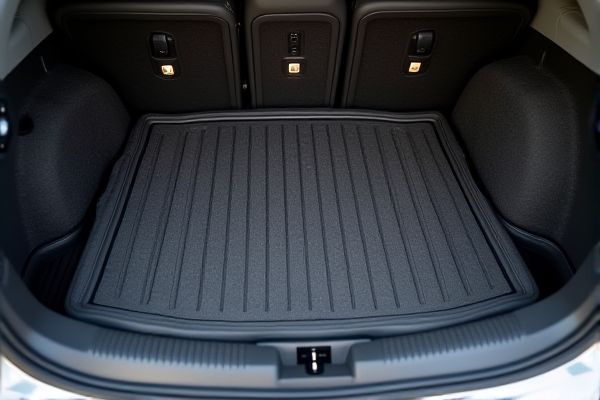
Boot trays offer raised edges and deep grooves to contain dirt, mud, and liquids, providing superior protection for your car's boot, while boot mats are generally flat and designed to shield the base from spills and debris. Discover which option best suits Your vehicle's needs by reading the rest of the article.
Table of Comparison
| Feature | Boot Tray | Boot Mat |
|---|---|---|
| Material | Rigid plastic or rubber | Flexible rubber or PVC |
| Design | Deep edges to contain dirt and water | Flat or slightly raised edges, textured surface |
| Purpose | Hold wet or muddy boots, prevent floor damage | Provide grip and catch minor dirt |
| Water Containment | High, prevents spills | Low, may let water escape |
| Cleaning | Easy to rinse or wipe | Easy to shake out and wash |
| Durability | Highly durable and stable | Durable but less rigid |
| Portability | Less flexible, bulkier | Lightweight and easy to move |
| Common Use | Entryways, mudrooms, garages | Inside doorways, near entrances |
Boot Tray vs Boot Mat: Key Differences
Boot trays feature raised edges that prevent mud, water, and dirt from spilling onto floors, making them ideal for containing messes from wet or muddy footwear. Boot mats are typically flat with a textured surface designed to trap dirt and debris beneath shoes without holding liquids, providing easy cleaning and quick drying. Choosing between a boot tray and boot mat depends on whether liquid containment or simple dirt trapping is the primary need for entryway protection.
Material Comparison: Boot Trays and Boot Mats
Boot trays are typically made from durable, waterproof materials such as heavy-duty plastic or rubber, designed to contain liquids and dirt efficiently. Boot mats often use softer materials like rubber blends or PVC with textured surfaces to provide grip and prevent slipping. Choosing between the two depends on your need for containment versus comfort and slip resistance for your footwear.
Design and Aesthetic Options
Boot trays offer a sleek and structured design, often made from durable materials like rubber or plastic with raised edges to contain dirt and moisture, making them practical and visually neat. Boot mats tend to have a softer, carpet-like texture that adds warmth and comfort to your space while still protecting floors from mud and water. Choosing between a boot tray and boot mat depends on your preference for a more utilitarian look versus a cozier, homey aesthetic for your entryway.
Durability and Longevity
Boot trays typically offer superior durability compared to boot mats, as they are often made from heavy-duty plastic or rubber designed to withstand harsh outdoor conditions and heavy footwear. Boot mats, while functional, are generally thinner and less resistant to wear and tear, making them more prone to cracking or fading over time. Choosing a boot tray enhances longevity, providing a reliable solution for protecting floors from dirt, moisture, and damage.
Water and Dirt Containment
A boot tray typically features raised edges and a deep base designed to contain water, mud, and dirt effectively, preventing messes from spreading onto your floors. A boot mat, while offering a waterproof surface, usually lacks the elevated sides necessary to fully trap liquids and debris, making it less efficient in containment. For superior protection against moisture and grime from wet or muddy boots, a boot tray provides more reliable water and dirt containment compared to a boot mat.
Ease of Cleaning and Maintenance
Boot trays feature raised edges that trap dirt, water, and mud, making them easier to clean by simply emptying and rinsing the tray. Boot mats, typically flat and made of rubber or vinyl, require more effort to clean thoroughly since debris can stick to the surface and edges. Both options benefit from quick drying materials, but boot trays generally reduce the spread of dirt and simplify maintenance with less frequent deep cleaning.
Size and Fit Considerations
Boot trays typically offer larger dimensions, designed to accommodate multiple pairs of boots and shoes, making them ideal for families or areas with high foot traffic. Boot mats are generally smaller and thinner, perfect for placing directly in entryways or under single pairs of boots, saving space while providing targeted protection. When choosing between a boot tray and a boot mat, consider your available space and the number of boots you need to organize to ensure Your choice fits both function and area requirements effectively.
Price and Value for Money
Boot trays generally offer a more affordable option with durable plastic construction, making them ideal for budget-conscious buyers seeking basic protection. Boot mats, while often priced higher, provide enhanced custom fit and superior material quality, delivering greater long-term value for those investing in a premium interior accessory. Your choice depends on balancing initial cost with the desired level of protection and longevity.
Best Uses for Boot Trays vs Boot Mats
Boot trays are ideal for organizing wet or muddy footwear in entryways, offering raised edges to contain water, dirt, and debris effectively, making them perfect for heavy-duty outdoor use. Boot mats provide a non-slip surface designed to protect floors from moisture and dirt while allowing boots to dry quickly, best suited for high-traffic areas with moderate exposure to moisture. Both products help maintain cleanliness, but boot trays excel in containment, whereas boot mats emphasize quick drying and floor protection.
Which Is Right for Your Entryway?
Boot trays offer elevated edges to contain dirt, water, and debris, making them ideal for heavy use in entryways prone to mud and snow. Boot mats provide a flat, absorbent surface that helps dry footwear while maintaining a low-profile look, suitable for lighter use and smaller spaces. Choosing between a boot tray and boot mat depends on your entryway's moisture levels, traffic, and aesthetic preferences.
 homyna.com
homyna.com